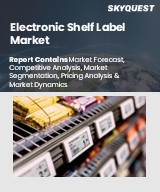
|
시장보고서
상품코드
1663110
전자종이 디스플레이 시장 규모, 점유율, 성장 분석 : 제품별, 기술별, 유형별, 최종사용자별, 지역별 - 산업 예측(2025-2032년)Electronic Paper Display Market Size, Share, and Growth Analysis, By Product (Auxiliary Displays, Electronic Shelf Labels), By Technology (Electrophoretic Display, Electrowetting Display), By Type, By End User, By Region - Industry Forecast 2025-2032 |
||||||
세계의 전자종이 디스플레이 시장 규모는 2023년에 51억 달러로 평가되며, 2024년 66억 8,000만 달러에서 2032년에는 579억 4,000만 달러로 성장하며, 예측 기간(2025-2032년)의 CAGR은 31.0%로 성장할 전망입니다.
전자 종이 디스플레이(EPD)는 소매 및 운송과 같은 전통적인 분야를 넘어 점점 더 다양한 용도로 사용되고 있으며, 전 세계에서 혁신적인 개발이 이루어지고 있습니다. 주목할 만한 프로젝트로는 일본의 E-Ink Holdings와 Papercast의 협업으로 스마트 버스 정류장에 태양광을 이용한 전자 종이 디스플레이를 도입하여 승객 안내 시스템을 강화하는 프로젝트가 있습니다. 한편, 예루살렘 교통 마스터플랜 팀은 통근자의 편의성을 향상시키기 위해 유사한 기술을 채택하고 있습니다. 소매 분야에서는 EPD가 급성장하고 있는 전자가격표시기(ESL)(ESL) 시장을 장악하고 있으며, 다양한 상품에 대한 기존의 종이 라벨을 관리하는 번거로운 작업을 크게 줄이고 있습니다. 이러한 소형 전자 종이 라벨은 역동적인 가격 책정을 가능하게 하는 동시에 직원들이 고객 서비스에 집중할 수 있도록 함으로써 업무 효율성을 최적화하고 소매 환경을 변화시키고 있습니다.
목차
서론
- 조사의 목적
- 조사 범위
- 정의
조사 방법
- 정보 조달
- 2차와 1차 데이터 방법
- 시장 규모 예측
- 시장의 전제조건과 제한
개요
- 세계 시장 전망
- 공급과 수요 동향 분석
- 부문별 기회 분석
시장 역학과 전망
- 시장 개요
- 시장 규모
- 시장 역학
- 촉진요인과 기회
- 억제요인과 과제
- Porter의 산업 분석
주요 시장 인사이트
- 주요 성공 요인
- 경쟁의 정도
- 주요 투자 기회
- 시장 에코시스템
- 시장의 매력 지수(2024년)
- PESTEL 분석
- 거시경제 지표
- 밸류체인 분석
- 가격 분석
- 사례 연구
- 기술 분석
- 특허 분석
전자종이 디스플레이 시장 규모 : 제품별 & CAGR(2025-2032)
- 시장 개요
- 보조 디스플레이
- 전자가격표시기
- 전자서적 리더
- 기타
전자종이 디스플레이 시장 규모 : 기술별 & CAGR(2025-2032)
- 시장 개요
- 전기영동 디스플레이
- 일렉트로웨팅 디스플레이
- 콜레스테릭 디스플레이
- 간섭계 모듈러 디스플레이
- 기타
전자종이 디스플레이 시장 규모 : 유형별 & CAGR(2025-2032)
- 시장 개요
- 플랫 EPD
- 커브드 EPD
- 플렉서블 EPD
- 폴더블 EPD
전자종이 디스플레이 시장 규모 : 최종사용자별 & CAGR(2025-2032)
- 시장 개요
- 자동차
- 가전
- 소매
- 헬스케어
- 미디어와 엔터테인먼트
전자종이 디스플레이 시장 규모 : 지역별 & CAGR(2025-2032)
- 북미
- 미국
- 캐나다
- 유럽
- 독일
- 스페인
- 프랑스
- 영국
- 이탈리아
- 기타 유럽 지역
- 아시아태평양
- 중국
- 인도
- 일본
- 한국
- 기타 아시아태평양
- 라틴아메리카
- 브라질
- 기타 라틴아메리카 지역
- 중동 및 아프리카
- GCC 국가
- 남아프리카공화국
- 기타 중동 및 아프리카
경쟁 정보
- 상위 5사의 비교
- 주요 기업의 시장 포지셔닝(2024년)
- 주요 시장 기업이 채택한 전략
- 최근 시장 동향
- 기업의 시장 점유율 분석(2024년)
- 주요 기업의 기업 개요
- 기업의 상세
- 제품 포트폴리오 분석
- 기업의 부문별 점유율 분석
- 매출의 전년대비 비교(2022-2024)
주요 기업 개요
- CLEARink Displays, Inc.(US)
- E Ink Holdings Inc.(Taiwan)
- Guangzhou OED Technologies Co., Ltd(China)
- InkCase Enterprise Pte Ltd(Singapore)
- Plastic Logic HK Ltd(Hong Kong)
- GDS Holding S.r.l.(Italy)
- Epson Europe Electronics GmbH(Germany)
- GDS S.p.a(Italy)
- Motion Display(India)
- Solomon Systech(Hong Kong)
- Visionect(Slovenia)
결론과 제안
KSA 25.03.31Global Electronic Paper Display Market size was valued at USD 5.1 billion in 2023 and is poised to grow from USD 6.68 billion in 2024 to USD 57.94 billion by 2032, growing at a CAGR of 31.0% during the forecast period (2025-2032).
Electronic Paper Displays (EPDs) are increasingly diversifying their applications beyond traditional sectors like retail and transport, showcasing innovative developments worldwide. Notable projects include the collaboration between E-Ink Holdings and Papercast in Japan, which has introduced solar-powered electronic paper displays for smart bus stops, enhancing passenger information systems. Meanwhile, the Jerusalem Transportation Master Plan Team has adopted similar technology to improve commuter experience. In the retail sector, EPDs dominate the fast-growing Electronic Shelf Label (ESL) market, significantly reducing the cumbersome task of managing traditional paper labels for various products. These miniature e-paper labels enable dynamic pricing, while allowing employees to focus on customer service, thus optimizing operational efficiency and transforming retail environments.
Top-down and bottom-up approaches were used to estimate and validate the size of the Global Electronic Paper Display market and to estimate the size of various other dependent submarkets. The research methodology used to estimate the market size includes the following details: The key players in the market were identified through secondary research, and their market shares in the respective regions were determined through primary and secondary research. This entire procedure includes the study of the annual and financial reports of the top market players and extensive interviews for key insights from industry leaders such as CEOs, VPs, directors, and marketing executives. All percentage shares split, and breakdowns were determined using secondary sources and verified through Primary sources. All possible parameters that affect the markets covered in this research study have been accounted for, viewed in extensive detail, verified through primary research, and analyzed to get the final quantitative and qualitative data.
Global Electronic Paper Display Market Segments Analysis
Global Electronic Paper Display Market is segmented by Product, Technology, Type, End User and region. Based on Product, the market is segmented into Auxiliary Displays, Electronic Shelf Labels, E-Readers, and Others. Based on Technology, the market is segmented into Electrophoretic Display, Electrowetting Display, Cholesteric Display, Interferometric Modular Display and Others. Based on Type, the market is segmented into Flat EPDs, Curved EPDs, Flexible EPDs and Foldable EPDs. Based on End User, the market is segmented into Automotive, Consumer Electronics, Retail, Healthcare and Media and Entertainment. Based on region, the market is segmented into North America, Europe, Asia Pacific, Latin America and Middle East & Africa.
Driver of the Global Electronic Paper Display Market
The growth of the Global Electronic Paper Display market is primarily driven by the increasing prevalence of smartphones and tablets, which have become essential tools in our daily lives. These devices' widespread usage significantly propels market expansion. Additionally, advancements in display technology are playing a crucial role, as the industry transitions from traditional resistive mono touch screens-known for their sluggishness and bulkiness-to advanced multi-touch capacitive screens. This technological evolution not only boosts sensitivity but also enhances precision and responsiveness, resulting in a more engaging and efficient user experience, further contributing to the growth of the e-paper display market.
Restraints in the Global Electronic Paper Display Market
The growth of the global electronic paper display market is expected to face several limitations during the forecast period from 2023 to 2030. Key challenges include the restricted capacity for video playback and the limited range of color vibrancy. These factors significantly impede the market's expansion, as the lack of robust support for video content and the inability of e-paper technology to produce rich color depths restricts widespread adoption and application in various industries. Consequently, addressing these constraints will be vital for driving future advancements and enhancing the overall appeal of electronic paper displays in a competitive landscape.
Market Trends of the Global Electronic Paper Display Market
The Global Electronic Paper Display market is witnessing significant growth driven by the increasing popularity of electronic readers and a rising demand for accessible information on-the-go. This trend highlights a robust consumer shift towards portable devices that offer versatility in format and ease of use. The continual evolution of user-friendly display technologies, emphasizing intuitive interfaces, further fuels market expansion, catering to diverse consumer needs for seamless, hassle-free information access. As a result, the market is positioned for sustained development, reflecting an ongoing commitment to innovation that aligns with modern digital consumption habits.
Table of Contents
Introduction
- Objectives of the Study
- Scope of the Report
- Definitions
Research Methodology
- Information Procurement
- Secondary & Primary Data Methods
- Market Size Estimation
- Market Assumptions & Limitations
Executive Summary
- Global Market Outlook
- Supply & Demand Trend Analysis
- Segmental Opportunity Analysis
Market Dynamics & Outlook
- Market Overview
- Market Size
- Market Dynamics
- Drivers & Opportunities
- Restraints & Challenges
- Porters Analysis
- Competitive rivalry
- Threat of substitute
- Bargaining power of buyers
- Threat of new entrants
- Bargaining power of suppliers
Key Market Insights
- Key Success Factors
- Degree of Competition
- Top Investment Pockets
- Market Ecosystem
- Market Attractiveness Index, 2024
- PESTEL Analysis
- Macro-Economic Indicators
- Value Chain Analysis
- Pricing Analysis
- Case Studies
- Technology Analysis
- Patent Analysis
Global Electronic Paper Display Market Size by Product & CAGR (2025-2032)
- Market Overview
- Auxiliary Displays
- Electronic Shelf Labels
- E-Readers
- Others
Global Electronic Paper Display Market Size by Technology & CAGR (2025-2032)
- Market Overview
- Electrophoretic Display
- Electrowetting Display
- Cholesteric Display
- Interferometric Modular Display
- Others
Global Electronic Paper Display Market Size by Type & CAGR (2025-2032)
- Market Overview
- Flat EPDs
- Curved EPDs
- Flexible EPDs
- Foldable EPDs
Global Electronic Paper Display Market Size by End User & CAGR (2025-2032)
- Market Overview
- Automotive
- Consumer Electronics
- Retail
- Healthcare
- Media and Entertainment
Global Electronic Paper Display Market Size & CAGR (2025-2032)
- North America (Product, Technology, Type, End User)
- US
- Canada
- Europe (Product, Technology, Type, End User)
- Germany
- Spain
- France
- UK
- Italy
- Rest of Europe
- Asia Pacific (Product, Technology, Type, End User)
- China
- India
- Japan
- South Korea
- Rest of Asia-Pacific
- Latin America (Product, Technology, Type, End User)
- Brazil
- Rest of Latin America
- Middle East & Africa (Product, Technology, Type, End User)
- GCC Countries
- South Africa
- Rest of Middle East & Africa
Competitive Intelligence
- Top 5 Player Comparison
- Market Positioning of Key Players, 2024
- Strategies Adopted by Key Market Players
- Recent Developments in the Market
- Company Market Share Analysis, 2024
- Company Profiles of All Key Players
- Company Details
- Product Portfolio Analysis
- Company's Segmental Share Analysis
- Revenue Y-O-Y Comparison (2022-2024)
Key Company Profiles
- CLEARink Displays, Inc. (US)
- Company Overview
- Business Segment Overview
- Financial Updates
- Key Developments
- E Ink Holdings Inc. (Taiwan)
- Company Overview
- Business Segment Overview
- Financial Updates
- Key Developments
- Guangzhou OED Technologies Co., Ltd (China)
- Company Overview
- Business Segment Overview
- Financial Updates
- Key Developments
- InkCase Enterprise Pte Ltd (Singapore)
- Company Overview
- Business Segment Overview
- Financial Updates
- Key Developments
- Plastic Logic HK Ltd (Hong Kong)
- Company Overview
- Business Segment Overview
- Financial Updates
- Key Developments
- GDS Holding S.r.l. (Italy)
- Company Overview
- Business Segment Overview
- Financial Updates
- Key Developments
- Epson Europe Electronics GmbH (Germany)
- Company Overview
- Business Segment Overview
- Financial Updates
- Key Developments
- GDS S.p.a (Italy)
- Company Overview
- Business Segment Overview
- Financial Updates
- Key Developments
- Motion Display (India)
- Company Overview
- Business Segment Overview
- Financial Updates
- Key Developments
- Solomon Systech (Hong Kong)
- Company Overview
- Business Segment Overview
- Financial Updates
- Key Developments
- Visionect (Slovenia)
- Company Overview
- Business Segment Overview
- Financial Updates
- Key Developments



















